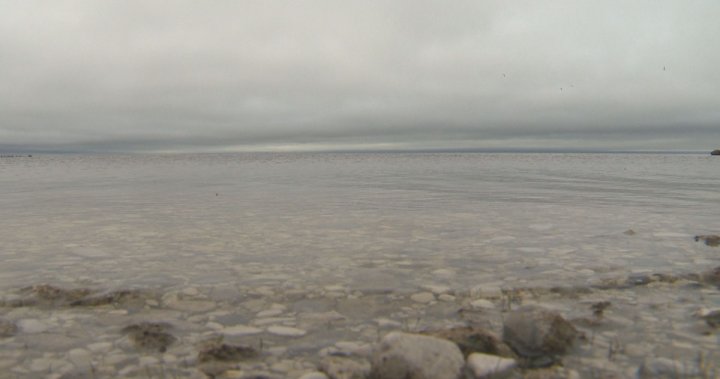First Nations communities in the Interlake, Man., region are hoping that new designs for a long-delayed flood mitigation project for Lake Manitoba and Lake St. Martin will address their concerns over its impact on Indigenous people in the area.
“We’re old timers, we like the land the way nature made it,” Lake Manitoba First Nation councillor Dwight Paul said while walking along the shores of Watchorn Bay on Lake Manitoba, where a proposed flood outlet channel is slated to go.
“But progress and life is progress and life, I guess.”
Lake Manitoba First Nation Councillor Dwight Paul stands along the shores of Watchorn Bay on Lake Manitoba, where the proposed flood outlet channel would start.
Jordan Pearn / Global News
After major flooding in 2011 devastated the region, and again in 2014, the province proposed two flood outlet channels, about 23 km each, which would divert flood waters from Lake Manitoba to Lake St. Martin and into Lake Winnipeg.
Lake Manitoba First Nation Chief Cornell McLean, who is also the chair of the Interlake Reserves Tribal Council, says First Nations need to be properly consulted and included in every step of the planning process — something he’s been calling for for years.
“We’re not against it, by any means. Lake Manitoba (First Nation), we’re not against it, but we want to be part of the process. So does the Interlake Tribal Council,” Chief McLean told Global News.
Lake Manitoba First Nation Chief Cornell McLean.
Jordan Pearn / Global News
The chief says it would have a major impact on their way of life and treaty rights for Indigenous communities in the area.

Get daily National news
Get the day’s top news, political, economic, and current affairs headlines, delivered to your inbox once a day.
“There’s going to be significant impact because of the fishing. We’re not natural resources, but we know that the control structures they’re going to put in place, either it will kill off the fish or are they going to be able to make it across those channels that they’re proposing?” the chief said.
“But what we do know is from the livelihood that our people sustain for their hunting and their medicine picking, (it) will be deeply impacted by this channel, and the environmental assessment proves that.”
Almost a year ago, an environmental impact assessment report from the federal government stated that the channels could have significant adverse environmental effects for dozens of First Nations communities in the Interlake.
The report is the reason why late last year, the province announced it was going back to the drawing board on the project, asking the federal government to pause environmental assessments in order to address concerns from First Nations.
“There was a good chance that the federal government would not approve the project. They felt strongly that the province had not met our obligations in terms of First Nations and the environmental issues,” said Lisa Naylor, Manitoba’s minister of transportation and infrastructure.
Lisa Naylor, Manitoba’s minister of transportation and infrastructure, says the province is currently working on a MOU with the Interlake Reserves Tribal Council over the proposed flood outlet channels.
Jordan Pearn / Global News
“This is a critical project for (preventing) flooding and keeping people safe and in their homes in the Interlake. So at that time, I asked them to pause the review to give us more time to rebuild the relationships with First Nations that were so badly damaged under the previous government.”
The province is currently working on a memorandum of understanding with the Interlake Reserves Tribal Council (IRTC), which represents seven communities in the Interlake, for the project.
Karl Zadnik, the chief executive officer of the IRTC, says the new designs will need to strike a balance, and currently, they’re feeling optimistic about the province taking their concerns seriously.
“We’re usually … the ones to be the sacrificial lambs. The north, the reserves, the land — we still use for our livelihoods, its sustenance and its medicines. The land is very sacred to us,” Zadnik said.
Karl Zadnik, the CEO of the Interlake Reserves Tribal Council, looks out over Watchorn Bay on Lake Manitoba.
Jordan Pearn / Global News
“We don’t know it’s in the First Nations’ best interest,” Zadnik added.
“Those two are at war with each other, public best interest versus First Nations best interest. So there’s no proof it will protect us, but there is proof it will protect the cottagers, the City of Winnipeg, the City of Brandon. So that’s where we’ve come to grips with our government; let’s design something that is going to protect both.”
Although the province previously stated the new designs would be completed this spring, Minister Naylor declined to provide a timeline to Global News.
“It takes time to rebuild those relationships and it takes time to work together and so that is what my focus (is on),” Naylor said.
“I can’t necessarily say if there will be any differentiation in design. What I can say is there may be some small alterations to avoid a burial ground, for example. We’re working with First Nations on what are their priorities to make sure we can do this project and do it in such a way that we keep Manitobans safe from future flooding.”
© 2025 Global News, a division of Corus Entertainment Inc.






